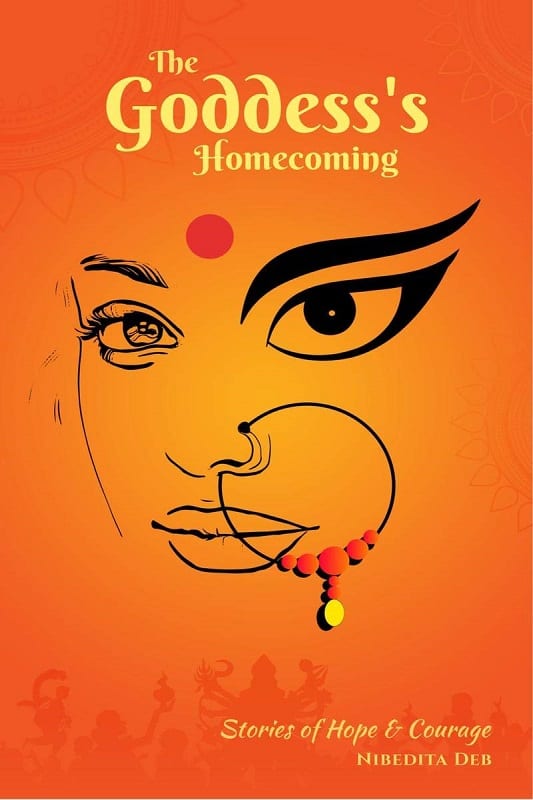Plot: 4/5
Characters: 4/5
Climax: 4/5
Writing Style: 4/5
Entertainment Quotient: 4/5
Robust yet benevolent, she is the epitome of strength, war, and protection. In Hindu mythology, she is depicted as the fierce mother Goddess. She combats evil, liberates the oppressed, and destroys the wrongdoers. She is Durga and every year Durgotsav is a celebration of her homecoming.
Durgotsav is also called Durga Puja or the Hindu festival celebrated by the worshippers of Maa Durga to commemorate her prowess, grace, and wisdom. In the Bengali tradition, Durga’s visit is considered as a journey to her natal home along with her children. The Goddess’s Homecoming is an anthology of stories marking the lives of several women.
These stories come with radical feminist leanings. They draw heavily on the tradition of Durgotsav and the quintessential Bengali love for storytelling to weave intricate tales of powerful women who remain largely in the shadows. The book is divided into five chapters marking the five most important days of Durgotsav.
It begins with Shoshti: The Sixth Element which is about Mohuli. She is a resident of Amchuria village of Purulia district that is shown to be facing its third consecutive year of drought. She is offered a job in the city to paint the make-shift Durga Puja pandals through Piya who is interning at an NGO in Amchuria. Mohuli is portrayed as a simple village woman who looks after the household chores, is proud of her tribe, and paints occasionally in her leisure time. The rural and urban finally meet when Mohuli travels to Kolkata to work for fifteen days at a pandal. It also dwells in the beauty of art that can always be redone, unlike life.
The next story is Shaptami: Seven Steps to Heaven. It is about Shreya who moves from Kolkata to Mohinpur in search of her missing husband but ends up setting an NGO in Mohinpur to help children fight drug addiction. The story comes with several twists and turns. A personal battle turns into a collective one when Shreya finds herself in a position to help the residents of Mohinpur. The different upheavals that she has to go through and the constant risks that she faces are highlighted through an episodic plot that moves at a fast pace.
The third story of The Goddess’s Homecoming is Ashtami: Anjali’s Eight Virtues. Set at Jorashingho Rajbari, this story follows the Kumari Puja or worshipping of an adolescent girl on the eight-day of Durga Puja. However, the twist in the tale comes when the people are to worship the daughter of a Vaishya- a prostitute. This was the decision taken by the royal family of the palace. What pans out is a tale that is written against the grain, beautifully evocative, and gladly surprising.
Next is the story Navami: The Ninth Rasa. It is about Mrinmayee who is at an audition at the Kolkata Kala Kendra. If chosen based on her performance then she is to get the opportunity to perform in front of hundreds at the annual Durgotsav. Extremely talented, a treat for the eyes, and with a bold concept, she is called in to explain her idea behind the choreography. What pans out is the imbibing of traditional Indian theatre philosophy with a young woman’s devotion.
Dashami: Vijayapath-The Road to Victory is the final story of The Goddess’s Homecoming. Pihu is returning to Jugi Para in the Bankura district of West Bengal from the USA. She is the pride of her para or local place. Rusticity kicks in that are charming in the narrative as the sounds, smells, and scenes are described with ease. But tension is in the air as family issues crop up while Pihu is put in the spotlight regarding the time she spent in the USA. As she settles in, a lot of questions crop up while Pihu is left alarmed at so many unexpected changes that have taken place in her absence. Like the previous ones, this story too has a lot of twists and turns that remain intertwined in the Durgotsav at Jugi Para.
The language of The Goddess’s Homecoming is easy to follow, neither too ornate nor too crisp. The third-person narrative voice is interspersed with dialogues. These dialogues have colloquial Bengali words and phrases that add to creating the ambiance of the place and situate the characters in the Bengali context. Nonetheless, the use of colloquial or regular Bengali phrases feels excessive at times for someone not well versed in Bengali.
The lack of a glossary of terms used in the text makes it difficult to follow through the narratives. One is bound to trip over these but the enticing plots don’t hinder readers from putting down the book on the whole. The descriptive nature of the narrative soothes the senses, calms the mind, and invigorates the sensual intake of the reader. This makes the descriptions pictorially visible before the mind’s eye.
In comparison, the book cover is rather simple and does not wholly reflect the beauty of the stories within. All the stories deal with a female protagonist and her journey into new zones that they have never been in before. This enhances their life experience but it is their sensibility and diligence that make for an engaging read.
The characters are wholesome bits of femininity chalked out with intelligence and brutal honesty. This keeps the readers on the edge and adds to the climax of the tales. The climax again has a good sense of balance. It is neither overwhelming nor fixed in discreet instances of brevity. It all enhances the reading experience of even a reader who is unfamiliar with Hindu mythology, traditional Bengali culture, or the rituals of Durgotsav in Bengal. The opening pages of the stories also come with typographic symbols that add to the aesthetic appeal of the book.
Can’t wait to read it? Buy your copy of “The Goddess’s Homecoming” using the link below
